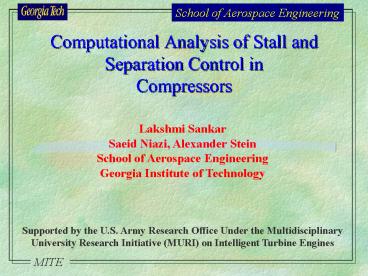Computational Analysis of Stall and Separation Control in Compressors
1 / 22
Title:
Computational Analysis of Stall and Separation Control in Compressors
Description:
DLR High-Speed Centrifugal Compressor. AGARD Test Case. 24 ... Higher speed, higher pressure compression systems. Turbulence model. Shock capturing capability ... –
Number of Views:392
Avg rating:3.0/5.0
Title: Computational Analysis of Stall and Separation Control in Compressors
1
Computational Analysis of Stall and Separation
Control in Compressors
Lakshmi Sankar Saeid Niazi, Alexander
Stein School of Aerospace Engineering Georgia
Institute of Technology Supported by the U.S.
Army Research Office Under the Multidisciplinary
University Research Initiative (MURI) on
Intelligent Turbine Engines
2
Motivation and Objectives
- Use CFD to explore and understand compressor
stall and surge - Develop and test flow control strategies
(air-injection, bleeding) for compressors - Apply CFD to compare low-speed and high-speed
configurations
Compressor instabilities can cause fatigue and
damage to entire engine
3
Summary of Earlier Accomplishments
- 2-D rotating stall was numerically modeled, and
the underlying physical phenomena studied - A 3-D flow solver capable of modeling unsteady
viscous flow through axial and centrifugal
compressors was developed and validated - The mechanisms behind the onset and growth of
surge in NASA Low Speed Centrifugal Compressor
was studied - Control of Surge through diffuser bleed was
simulated
4
How to Control Surge (Passive Control)
- Diffuser bleed valves
- Pinsley, Greitzer, Epstein (MIT)
- Prasad, Neumeier, Haddad (GT)
- Movable plenum wall
- Gysling, Greitzer, Epstein (MIT)
- Guide vanes
- Dussourd (Ingersoll-Rand Research Inc.)
- Air-injection
- Murray (Cal Tech)
- Fleeter, Lawless (Purdue)
- Weigl, Paduano, Bright (MIT NASA Lewis)
5
Boundary Conditions (GTTURBO3D)
Periodic Boundary at clearance gap
Solid Wall Boundary at impeller blades
Solid Wall Boundary at compressor casing
Inflow Boundary
Periodic Boundary at diffuser
Solid Wall Boundary at compressor hub
Outflow boundary (coupling with plenum)
Periodic Boundary at compressor inlet
6
Outflow BC (GTTURBO3D)
Conservation of mass
7
DLR High-Speed Centrifugal CompressorAGARD Test
Case
- 24 main blades
- 30? backsweep
- CFD-grid 141 x 49 x 33 (230,000 grid-points)
- Design Conditions
- 22360 RPM
- Mass flow 4.0 kg/s
- Total pressure ratio 4.7
- Adiab. efficiency 83
- Exit tip speed 468 m/s
- Inlet Mrel 0.92
8
DLRCC-Results (Off-Design Conditions)
Performance Characteristic Map
Unsteady fluctuations are denoted by size of
circles
Fluctuations at 3.1 kg/sec are 30 times larger
than at 4.6 kg/sec
9
DLRCC-Results (Surge Conditions)
Mild surge develops.
Surge amplitude grows to 60 of mean flow rate.
Surge frequency 94 Hz (1/100 of blade passing
frequency)
10
DLRCC-Results (Surge Conditions)
Mild surge cycle colored by Mrel
- Flow field vectors show two separation zones
- near leading edge
- in the diffuser
11
DLRCC-Results (Surge Conditions) Stagnation
pressure contours
Direction of rotation
- Vortex shedding causes reversed flow
- Origin of separation occurs at leading edge
pressure side
12
LSCC-Results (Air-Injection)
Injection angle, ? 5º 3 to 10 injected mass
flow rate
13
DLRCC-Results (Air-Injection) Different yaw
angles, 3 injected mass flow rate
Positive yaw angle is measured in positive
direction of impeller rotation
Yaw angle directly affects the unsteady leading
edge vortex shedding
14
DLRCC-Results (Air-Injection)
Velocity vectors colored by Mrel
Leading edge separation suppressed due to
injection
15
DLRCC-Results (Air-Injection) Different yaw
angles, 3 injected mass flow rate
16
Axial Compressor (NASA Rotor 67)
- 22 Full Blades
- Inlet Tip Diameter 0.514 m
- Exit Tip Diameter 0.485 m
- Tip Clearance 0.61 mm
- 22 Full Blades
- Design Conditions
- Mass Flow Rate 33.25 kg/sec
- Rotational Speed 16043 RPM
- Rotor Tip Speed 429 m/sec
- Inlet Tip Relative Mach Number 1.38
- Total Pressure Ratio 1.63
- Adiabatic Efficiency 0.93
Multi-flow-passage-grid for rotating stall
modeling
17
Performance Map (NASA Rotor 67)
- measured mass flow rate at choke 34.96 kg/s
- CFD choke mass flow rate 34.76
kg/s
18
Mach Contours at Midspan
Spatially uniform flow at design conditions
19
Summary of Current Year Work
- The CFD compressor modeling capability was
extended to - Higher speed, higher pressure compression
systems - Turbulence model
- Shock capturing capability
- Boundary conditions
- Development of surge mechanism in centrifugal
compressors was studied. Surge Control through
upstream injection was optimized - In preparation for rotating stall simulations, a
multi-blade passage version of the solver was
developed and validated
20
Future and Planned Activities
- 3-D rotating stall phenomenon and efficient stall
control in axial compressors (bleeding, vortex
generators) will be modeled - Develop a criterion for efficient injection
control of centrifugal compressors - Examine the effectiveness of control laws
developed by Drs. Haddad, Prasad and Neumeier
through CFD-simulations
21
Technology Transition
- The suite of codes may be used by industry
partners for pilot studies of promising
concepts - Compact size of the code
- Optimized for turbomachinery applications
- Advanced analysis features (fifth order Roe
solver, implicit time marching algorithm,
Spalart-Allmaras model) - Documentation is available
- Optimized injection control scheme may be
implemented in real engines - Injection location
- Injection rates
- Injection angles
22
DLRCC-Results (Design Conditions) Static
Pressure Along Shroud
Excellent agreement between CFD and experiment































